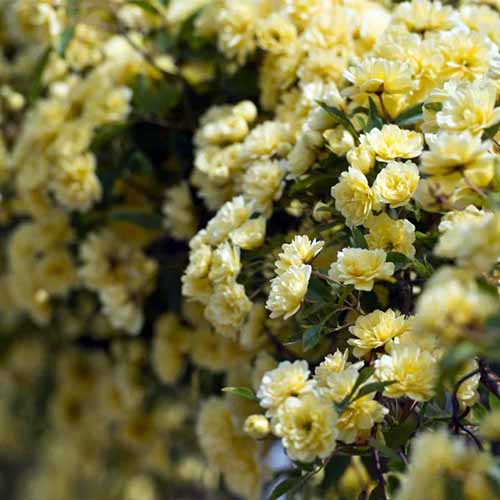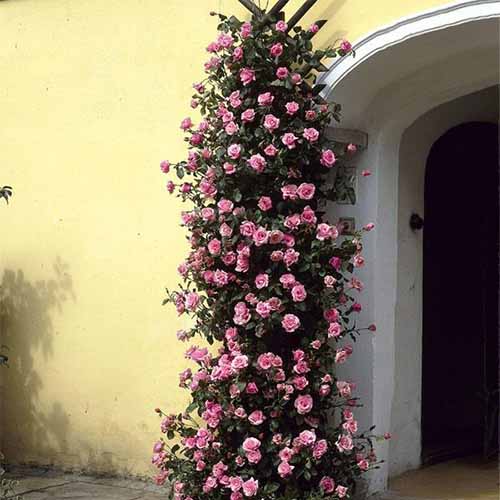29 Roses with Few or No Thorns for Your Garden
I know, I know. The song says that “every rose has its thorn.” But does it really?
Breeders have been working for a long time to make roses that don’t shred your arm to pieces when you walk by or go out to take a stem or two for an arrangement.
These days, some incredibly stunning blossoms are attached to totally thornless stems. Some others are nearly so, with thorns that are broadly spaced, or not nearly so firm and sharp as the thorns we picture when someone mentions being stuck by a rose.


We link to vendors to help you find relevant products. If you buy from one of our links, we may earn a commission.
Even if you aren’t trying to make a beautiful arrangement, thornless (or nearly prickle-free) roses are perfect for planting along walkways or in other high-traffic areas.
If you’ve ever walked down a sidewalk and wound up trying to disentangle yourself from an aggressive rambler, you know what I’m talking about.
Coming up, we’re going to chat about 29 of the best nearly or completely thornless roses out there. Here are the ones that we’ll go over:
Best Thornless Roses
Botanically, there aren’t any roses that actually have thorns. Isn’t that a relief? Nope, they have prickles, instead.
Next time you’re pulling a hooked barb out of your skin, remind yourself that you aren’t dealing with a thorn really. It’s a perfectly innocent prickle.
All sarcasm aside, a prickle is a sharp growth that extends from the bark of a stem. A thorn is an actual stem that ends in a point.
The difference is immaterial when you’re putting on a bandage and cursing your plant. I just dug a prickle out of my thumb that had been embedded for over a week, and I can assure you, the nuances of its particular anatomy didn’t matter to me. But it’s nice to know the terminology.
1. Amadis
‘Amadis’ is one of the original Boursault roses, a hybrid tea variety bred in the 1820s in France. It grows up to 15 feet tall on thornless canes covered in apple green foliage and clusters of mauve, semi-double flowers.
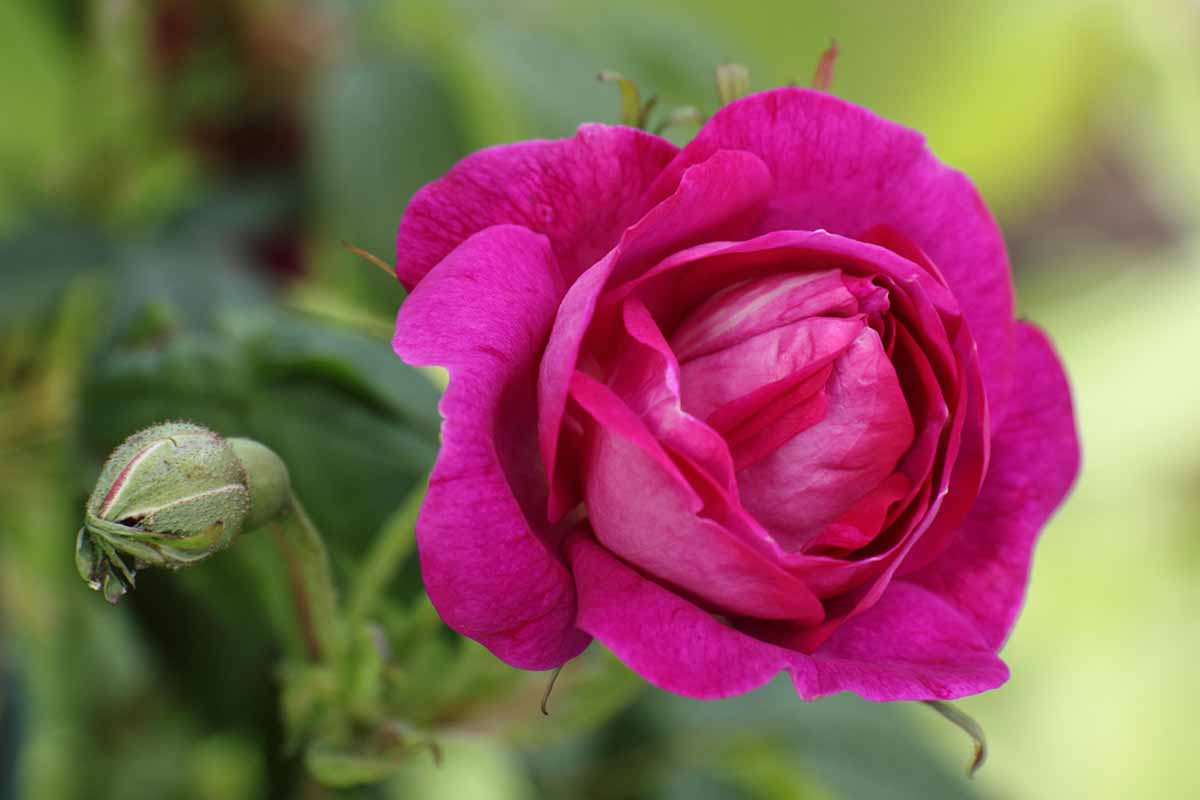

This cultivar blooms only once per season but profusely, and it is suitable for growing in USDA Hardiness Zones 5 to 9.
2. Bleu Magenta
This magnificent beauty is one of the so-called “blue ramblers,” a group of climbing multifloras. It was bred by horticulturist and master gardener Louis Benoit Van Houtte and hit the market in 1876.
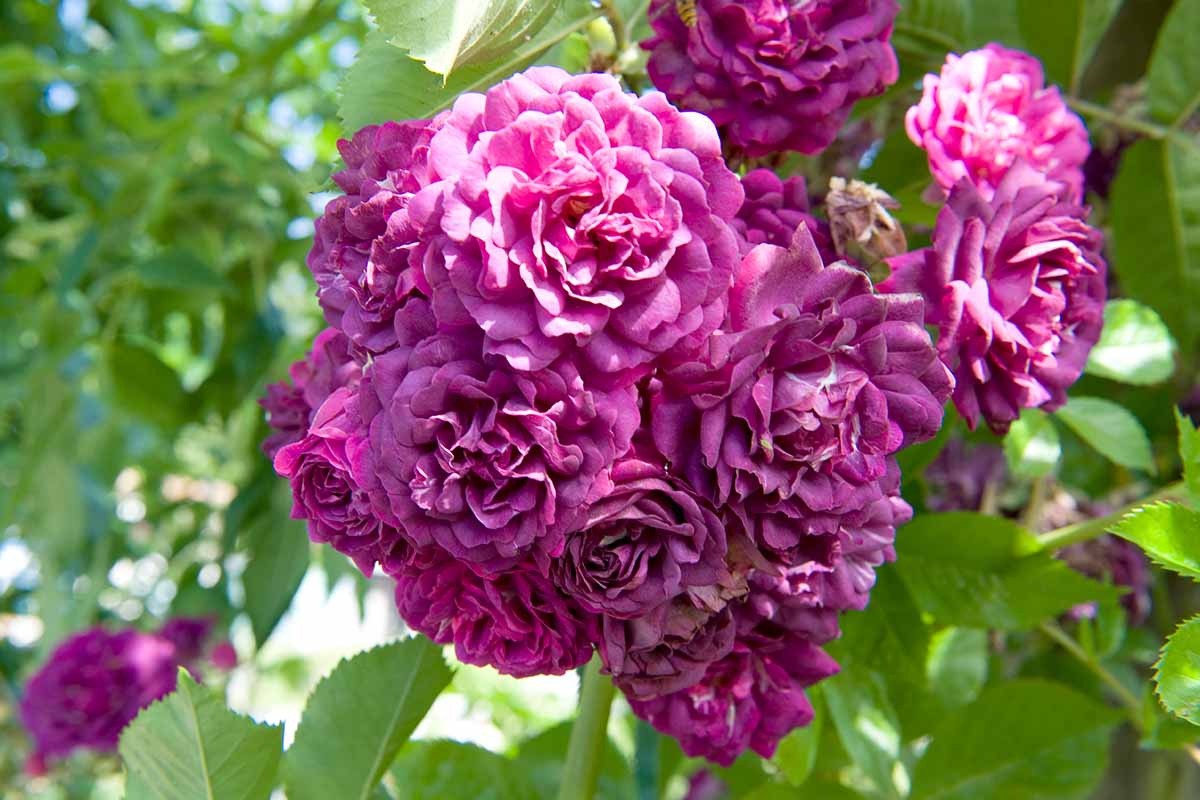

When mature, the fully double flowers are a sight to behold. They open a crimson-purple and gradually transition to a deep, true purple. Then, as the flower fades, it turns nearly blue.
You’ll love the nonstop transitioning display on this 15-foot climber that grows well even in partial shade. It’s happy in Zones 5 to 10.
This plant is a little unusual because the colors of the blossoms change over the years, as well as throughout the growing season. When the plant is young, the petals are rosy pink.
As plants mature, they gradually begin to emerge darker and darker until they take on the deep purple hue that characterizes this plant.
3. Brother Cadfael
No mystery to solve, here. It’s obvious why this David Austin cultivar is so beloved.
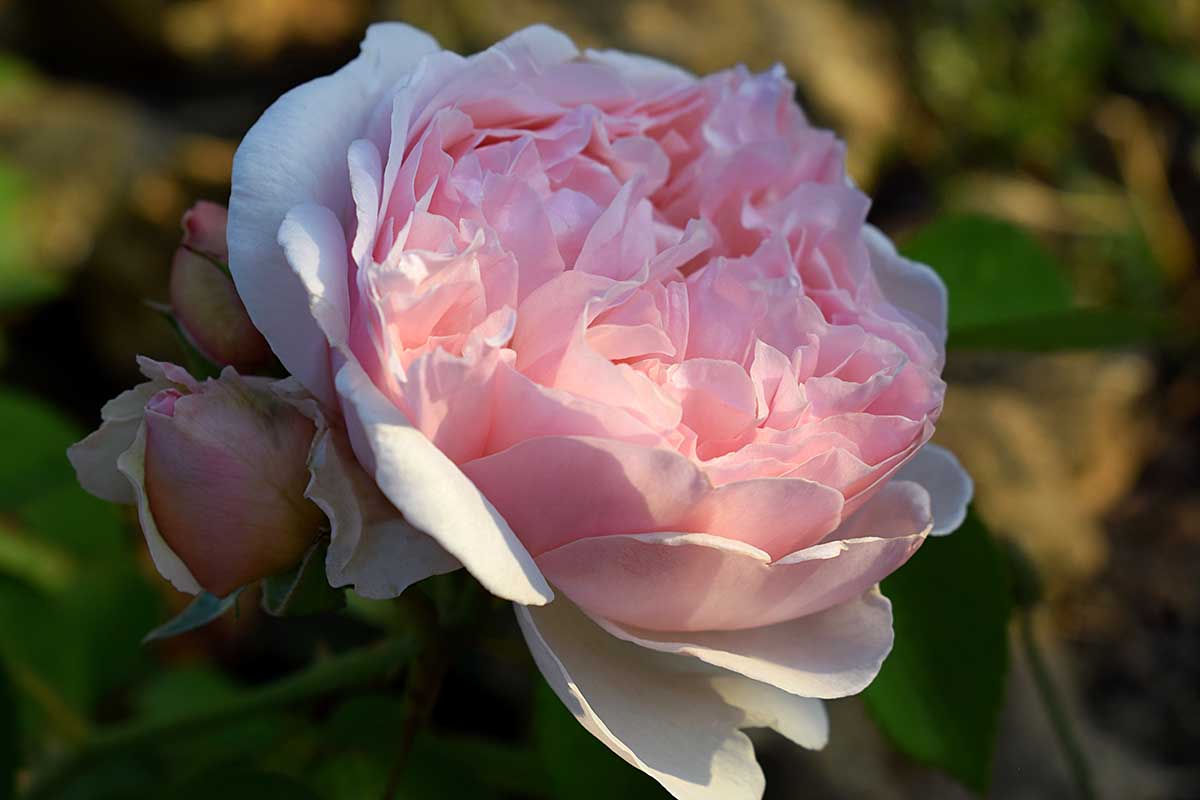

You could easily mistake the large, fully double, pink flowers for peonies. That is, until you go in to smell them and are greeted by a heady rush of classic rose fragrance.
This five-foot shrub is nearly thornless and grows in Zones 5 to 11.
4. Chloris
Heralding spring, this alba is nearly thornless, and has long, straight canes, which make it good for cutting.
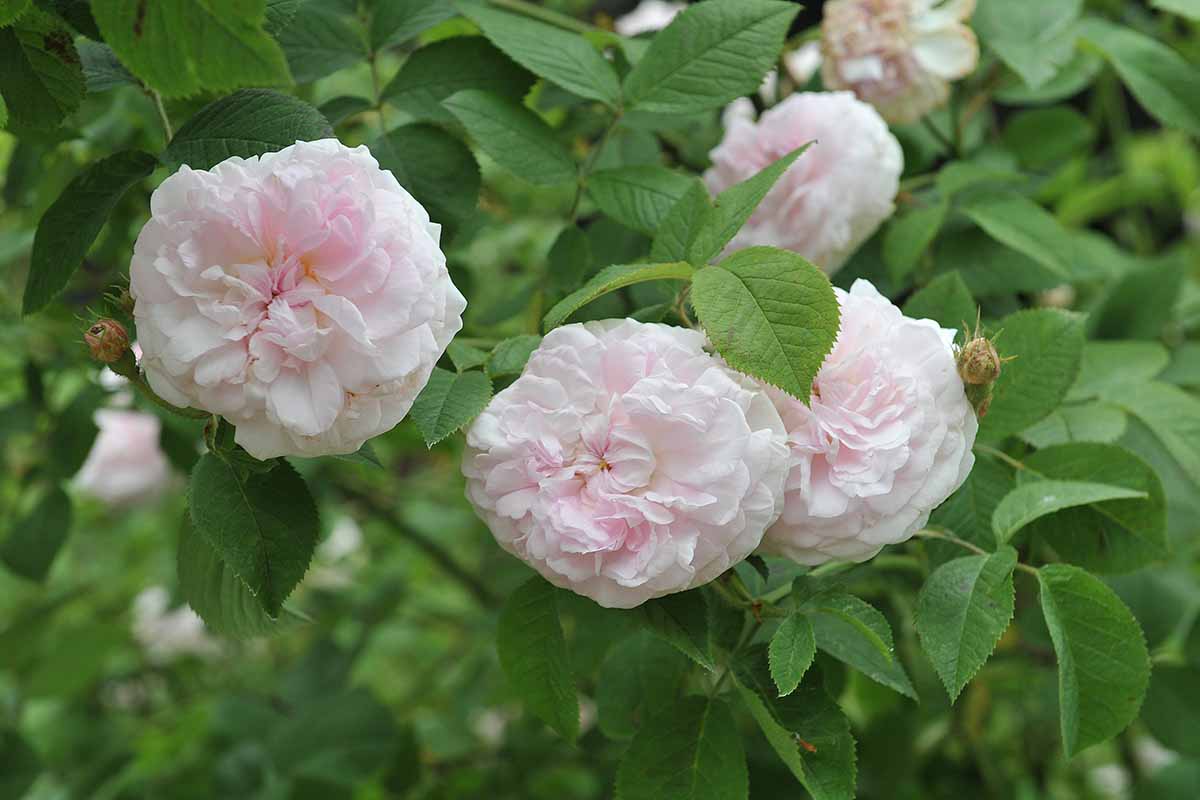

Bred by horticulturist Jacques-Louis Descemet in 1815, the pink, fragrant blossoms are double. The shrub reaches about six feet tall and is cold tolerant down to Zone 3, and gardeners can enjoy it in warmer regions through Zone 9.
Like all good wood nymphs, this beauty is equally happy basking in full sun as it is in partial shade.
5. Cinderella
Respected Dutch breeder Jan de Vink bred ‘Cinderella’ from polyanthas in the 1950s to create a sweet little princess dressed up in a full white-and-blush-pink ball gown.
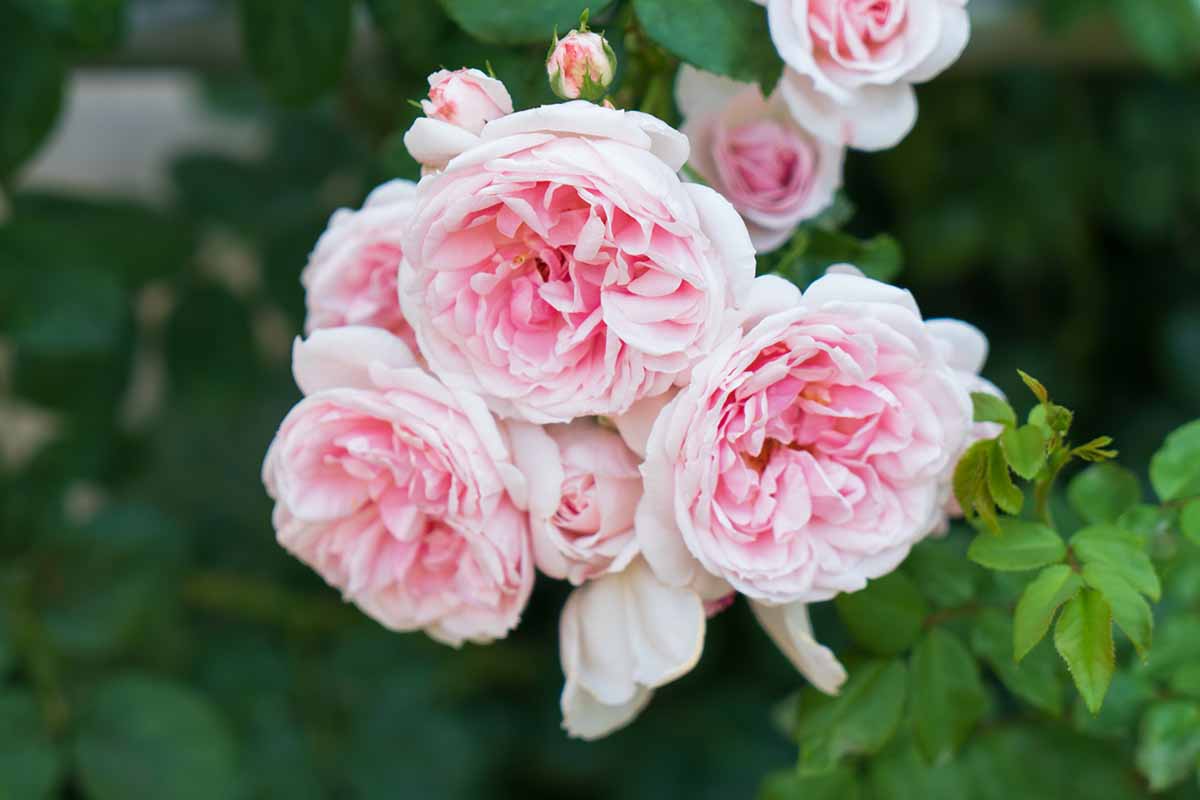

This miniature rose stays under two feet tall, but don’t mistake her petite stature for fragility. She’s a hardy repeat bloomer down to Zone 5.
6. Climbing Pinkie
With bright pink semi-double blossoms on arching canes, this nearly thornless option can be grown as a climber or as a gracefully arching shrub in Zones 6 to 9.
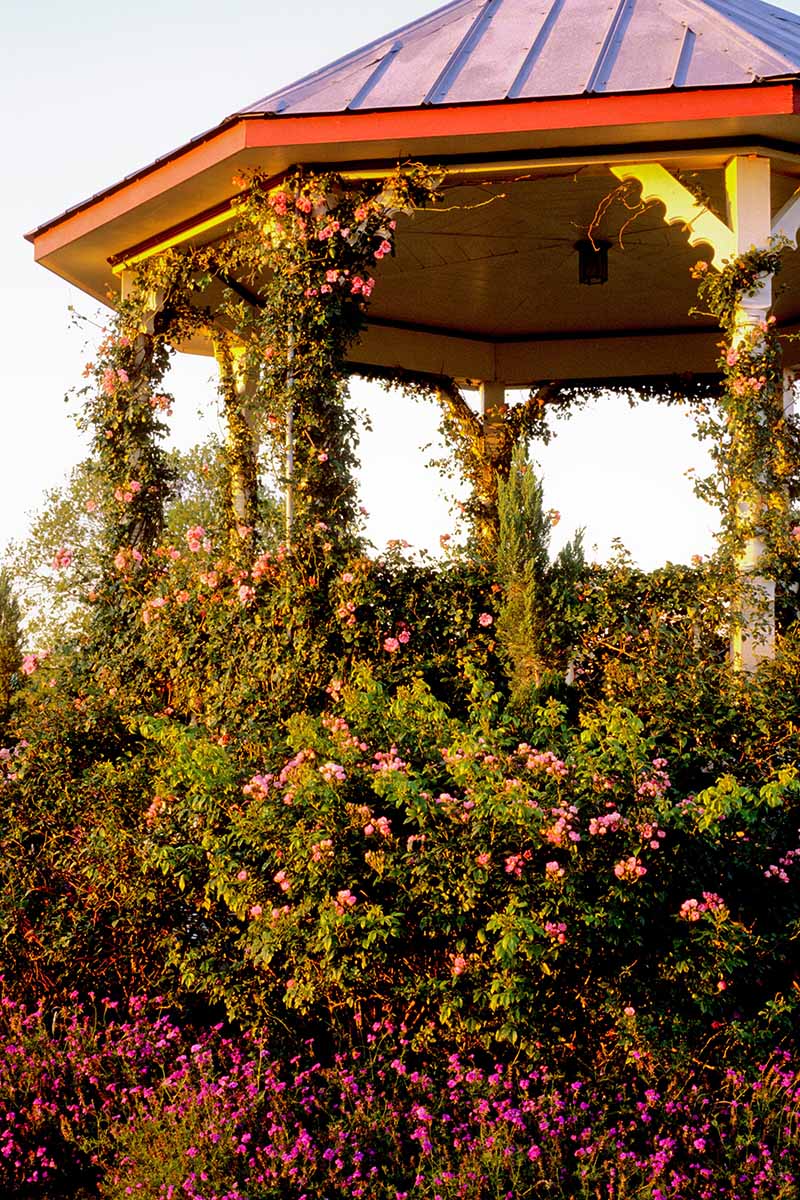

A polyantha, it blooms continuously and prolifically throughout the late spring and early summer. This sport of ‘Pinkie’ crossed with ‘China Doll’ was introduced in 1952.
7. Goldfinch
Don’t go assuming when we tell you that the semi-double flowers on this plant are petite that the display is less than amazing.
Yes, each yellow, fruity-smelling blossom is the size of a goldfinch, but they form in such dense clusters that you can hardly tell there’s any foliage underneath.
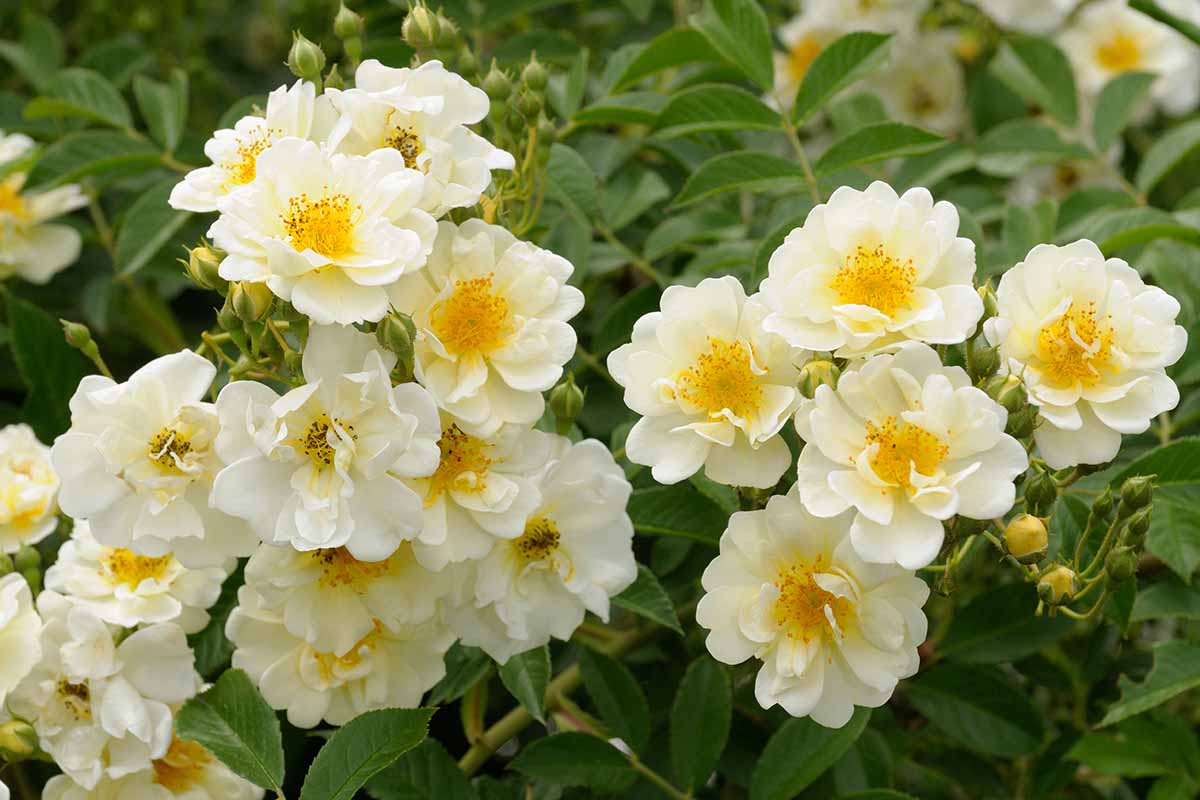

This multiflora was hybridized by noted rose breeder George Paul in 1867, and grows up to 10 feet tall with nearly thornless canes. Suitable for Zones 5 to 9.
8. Hippolyte
The intensely bright, full mauve-violet blossoms on ‘Hippolyte’ have a pom-pom-like shape that stands out from the apple green, corrugated foliage.
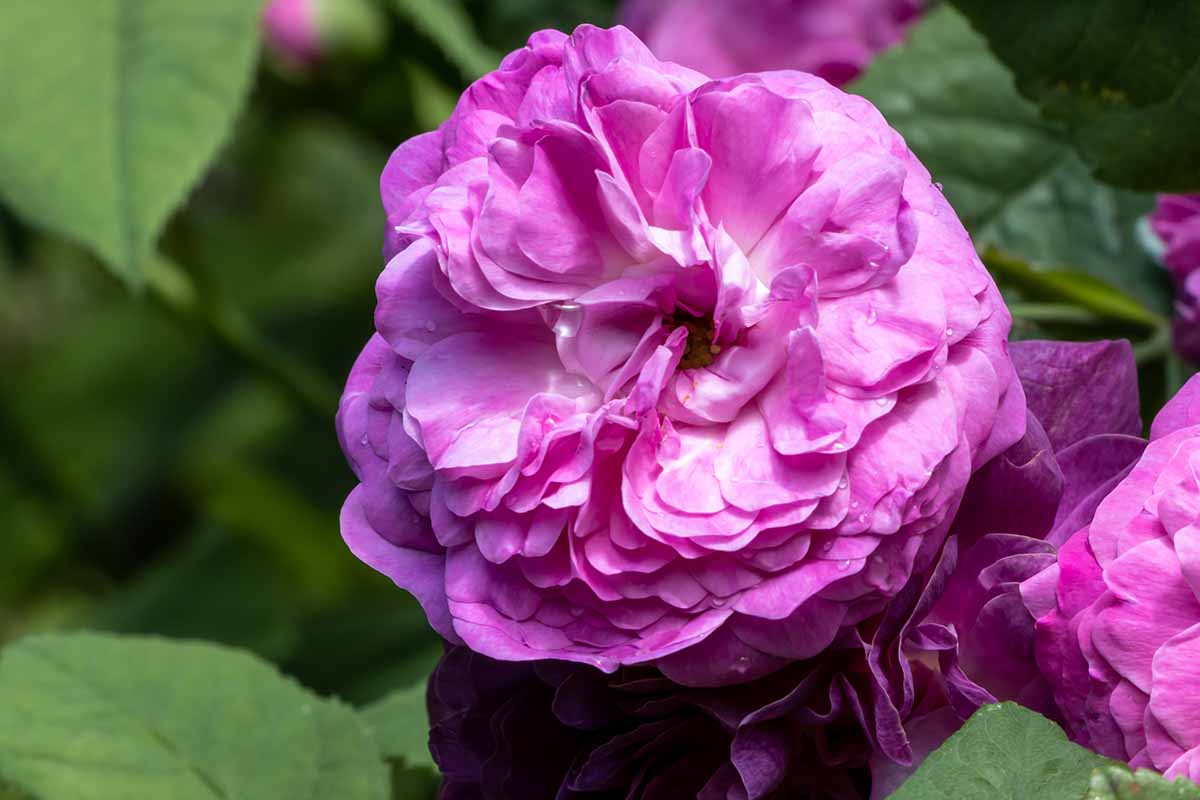

While some Gallicas have a reputation for being a bit, shall we say, fussy, this one isn’t. It’s disease-resistant and can even grow well in partial sun.
It only blooms once per season, however, so enjoy it while you can.
9. Kathleen Harrop
A nearly thornless climber that reaches about eight feet tall, this rose was first introduced in 1919 and has stayed popular thanks to its long-blooming habit and delicate pink, fragrant, semi-double blossoms.
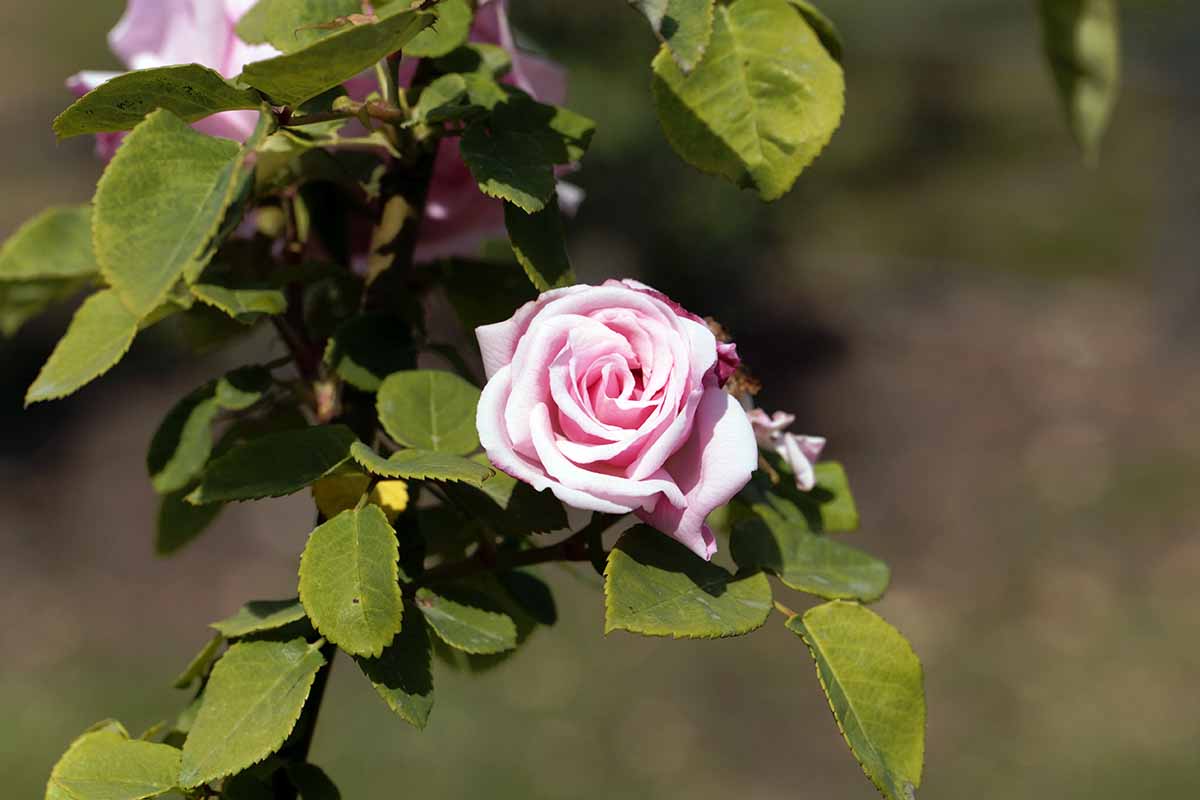

‘Kathleen Harrop’ is a Bourbon rose and a sport of ‘Zéphirine Drouhin,’ which we’ll talk about in just a bit. It’s hardy down to Zone 5.
10. Kew Gardens
‘Kew Gardens’ doesn’t look like most roses on this list. It resembles a very full, prolifically-blooming wild rose.


Each blossom is small, white, and single, with a golden center, but the blossoms are clustered in massive groups, giving the overall effect of a shrub completely smothered in white petals.
This cultivar stays under four feet tall and is completely thornless, perfect as a hedge or a specimen next to a door or walkway. It’s also incredibly healthy and reliable.
A hybrid musk variety, it flowers repeatedly throughout the summer and is hardy down to Zone 5.
11. Lady Banks
With long, arching branches, the species R. banksiae aka Lady Banks rose looks less like a shrub and more like a fountain of cheerful yellow (‘Lutea’) or white double blossoms (‘Alboplena’).
It can also be trained into a climbing habit and will reach up to 15 feet tall.
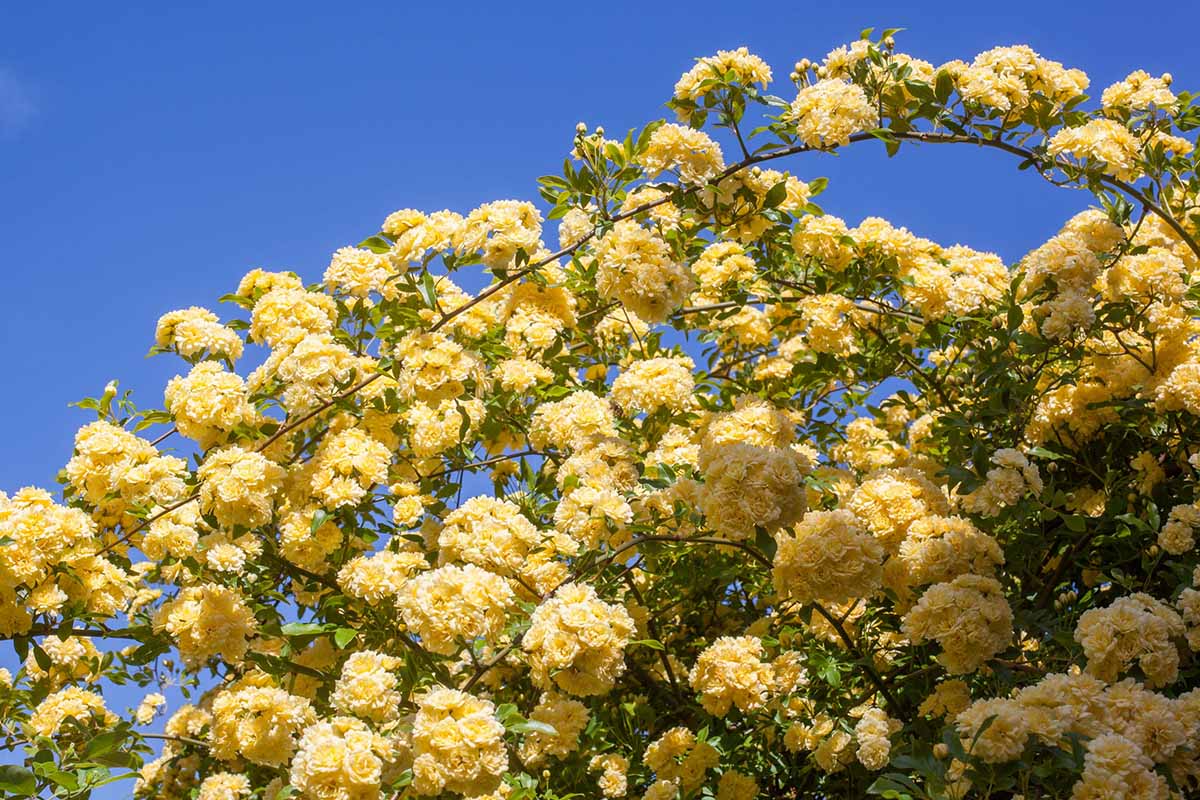

To say that the plant is covered in blossoms is an understatement. When it’s in full bloom, you’ll be lucky to even get a glimpse of the foliage underneath the clusters of flowers.
This Lady’s only flaw is that she only blooms one time per season and she’s done. But while in bloom, the display is incomparable. Hardy to Zone 6.
Make her part of your dream garden by grabbing one at Fast Growing Trees.
12. Lady Hillingdon
‘Lady Hillingdon’ needs to be examined up close to really appreciate her. The petals are particularly large and slightly pointed, creating an interesting, scrolled pom-pom. The apricot-yellow blossoms are semi-double and have a strong tea fragrance.
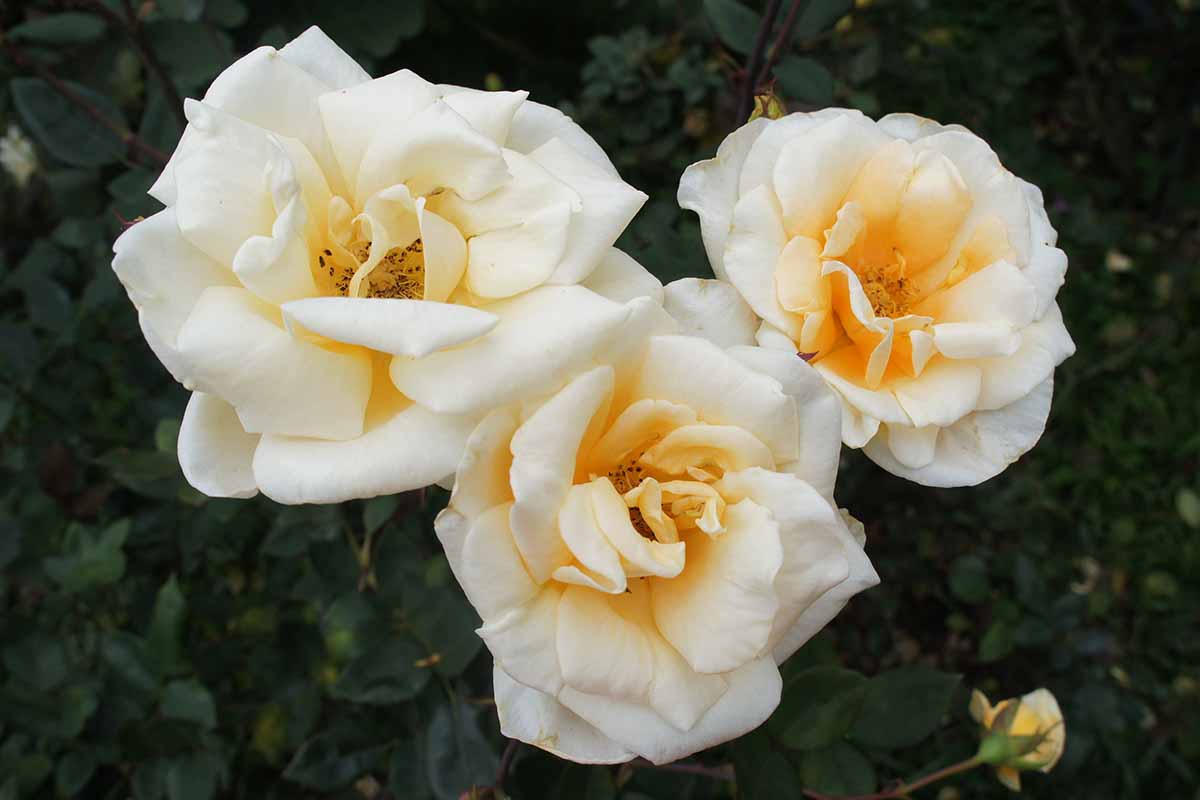

Left to her own devices, she can grow up to 20 feet tall, but takes well to pruning. There’s also a bush form available that stays much more compact. Both of these flower nonstop from spring until frost.
13. Lichfield Angel
Creamy peach, large, fully double blossoms grow on five-foot canes on this David Austin showstopper. It has a light musk scent, does well in partial shade, and flowers all summer long.
On top of that, it can grow in a massive range of climates (for a rose), all the way from Zone 4 through 11.
It does have a few prickles, but they’re petite, few, and far between. Mine happily grows next to my driveway and I’ve never had to try to extract myself from its clutches.
14. Lykkefund
A rambler that can stretch its limbs up to 20 feet, ‘Lykkefund’ needs lots of space.
But give it the room it craves and you’ll be rewarded with a bush absolutely smothered in white, semi-double, heavily fragrant flowers that appear through spring and summer.


It’s a hybrid of a Helen rambler and the aforementioned Bourbon rose called ‘Zéphirine Drouhin,’ which we’ll cover shortly. It was bred by Danish botanist Aksel Olsen and introduced in 1930.
15. Madame Alfred Carriér
A sweet noisette bred by Schwartz in 1879, this is a beloved classic that tends to appear on many a rosarians’ best-loved list.
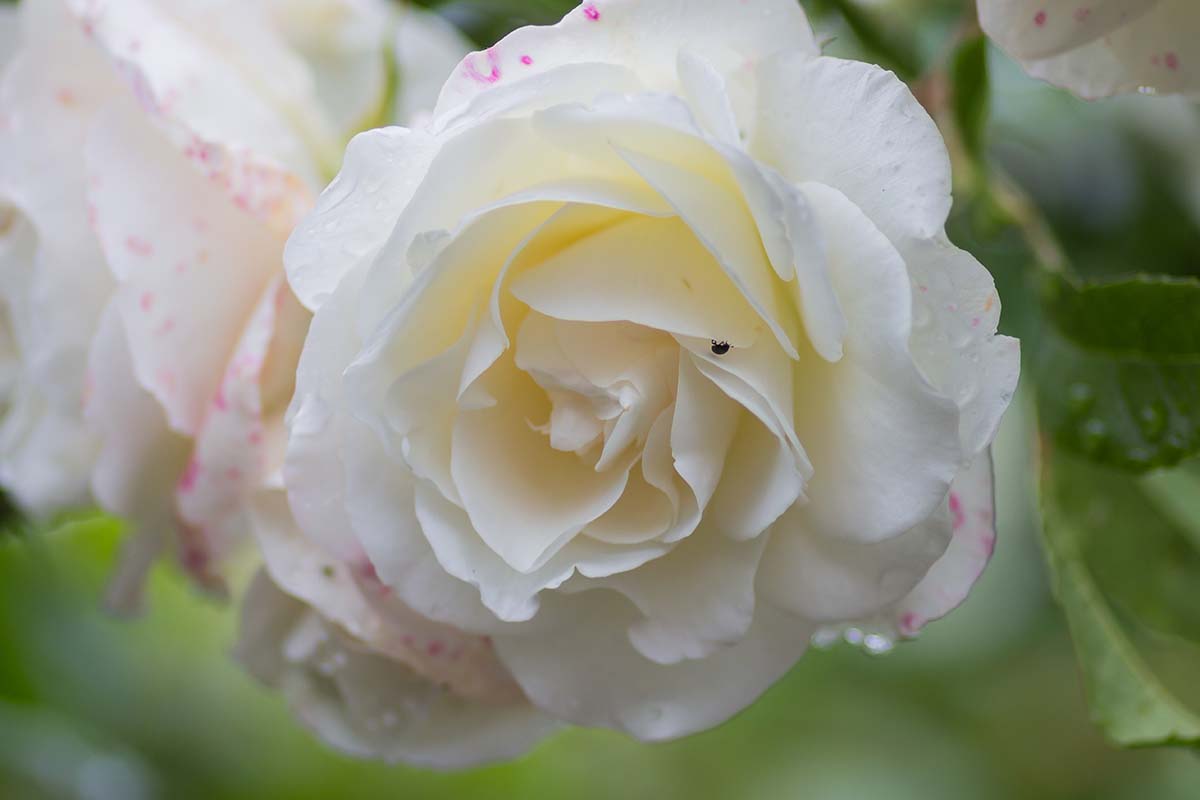

‘Madame Alfred Carriér’ features creamy white blossoms tinged in pink, with a fruity fragrance on nearly thornless stems that can reach 25 feet long.
It’s one of the most consistent and earliest bloomers I’ve ever worked with. When some roses were barely forming buds, it had big, bold blossoms already. It’s also exceptionally disease resistant. Truly a nearly fuss-free Old Rose.
16. Madame Legras de St. Germain
Introduced in the mid-1800s, this elegant ivory alba has lemon undertones at the center of each fully double blossom. Grow it as a climber or an arching shrub, with its nearly thornless 15-foot-long canes.
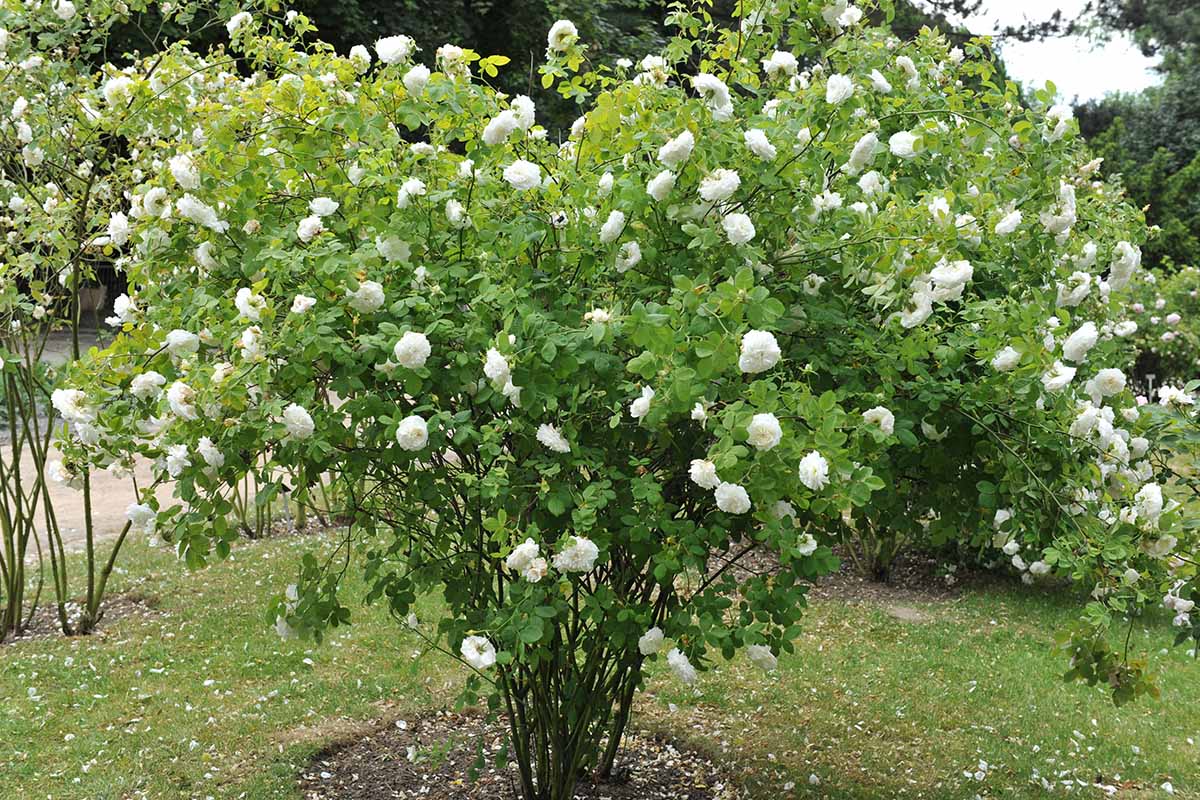

You can grow this rose in Zones 4 to 9, or even Zone 3 if you’re willing to provide a little protection.
It only blooms once in the early summer and then you’ll need to deadhead it. Prune during the dormant season to maintain a tidy shape and encourage new blossoms.
17. Madame Plantier
Noisette roses are known for being prolific bloomers. Albas have a pleasing growth habit and are pretty darn resistant to diseases. When you combine the two, the result is something like ‘Madame Plantier.’


In addition to all those desirable traits, it can handle partial shade but will keep on blooming with big, fully double, heavily fragrant white blossoms. It can be trained as a climber or left as a delicately weeping shrub, and is hardy down to Zone 3b.
Her only failing is that she blooms once per season and then stops. I think if she was a repeat bloomer, she could easily be one of the best roses out there.
No doubt Monsieur Plantier of Lyon, France, who introduced this rose in 1835, would be happy to know that his legacy is firmly secured with this stately beauty.
18. Marie Pavie
While this rose doesn’t have the massive, showy blossoms that some people prefer, it makes up for that with sheer exuberance.
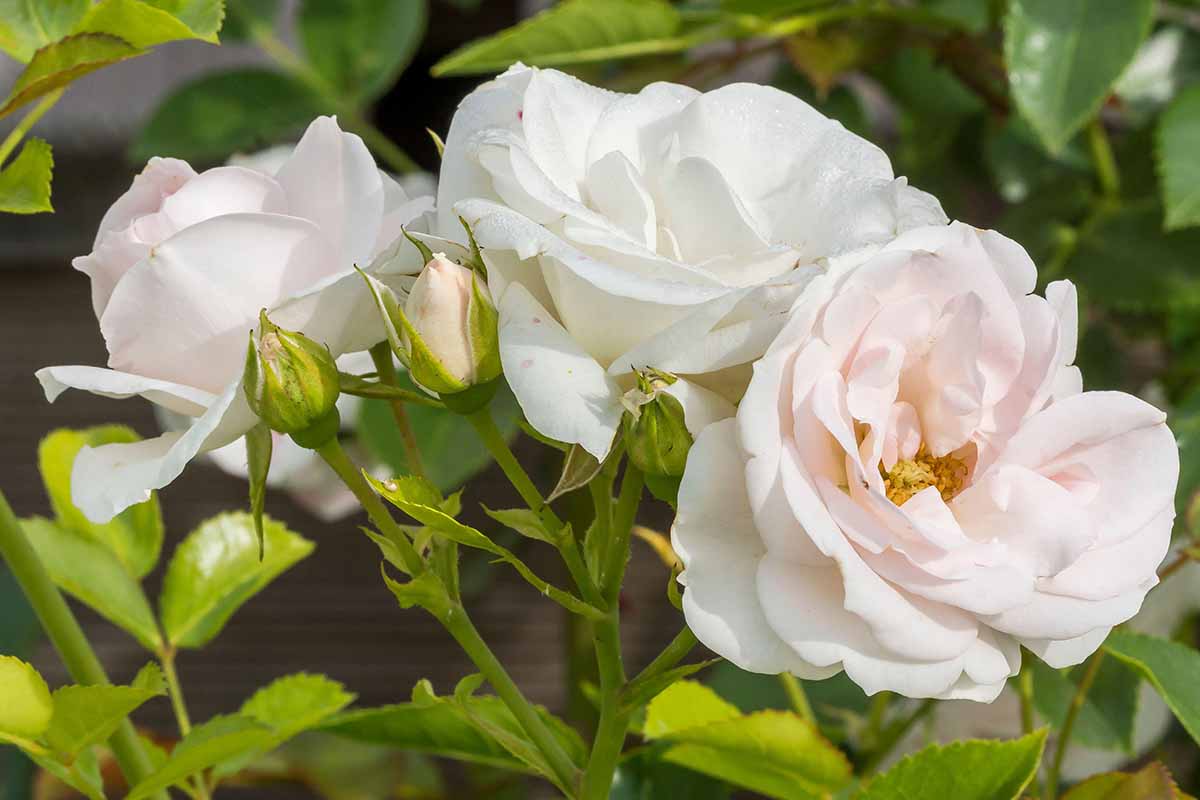

The semi-double flowers are pale pink with a darker pink center and are highly fragrant, in clusters of up to 12 flowers. They are held gently at the end of four-foot stalks like a pink cloud shrouding the bush.
‘Marie Pavie’ does well in Zones 5 to 9, and is an excellent option for container growing.
19. Mary Delany
No doubt when David Austin bred ‘Mary Delany’ in 2002, he knew he had a winner on his hands.
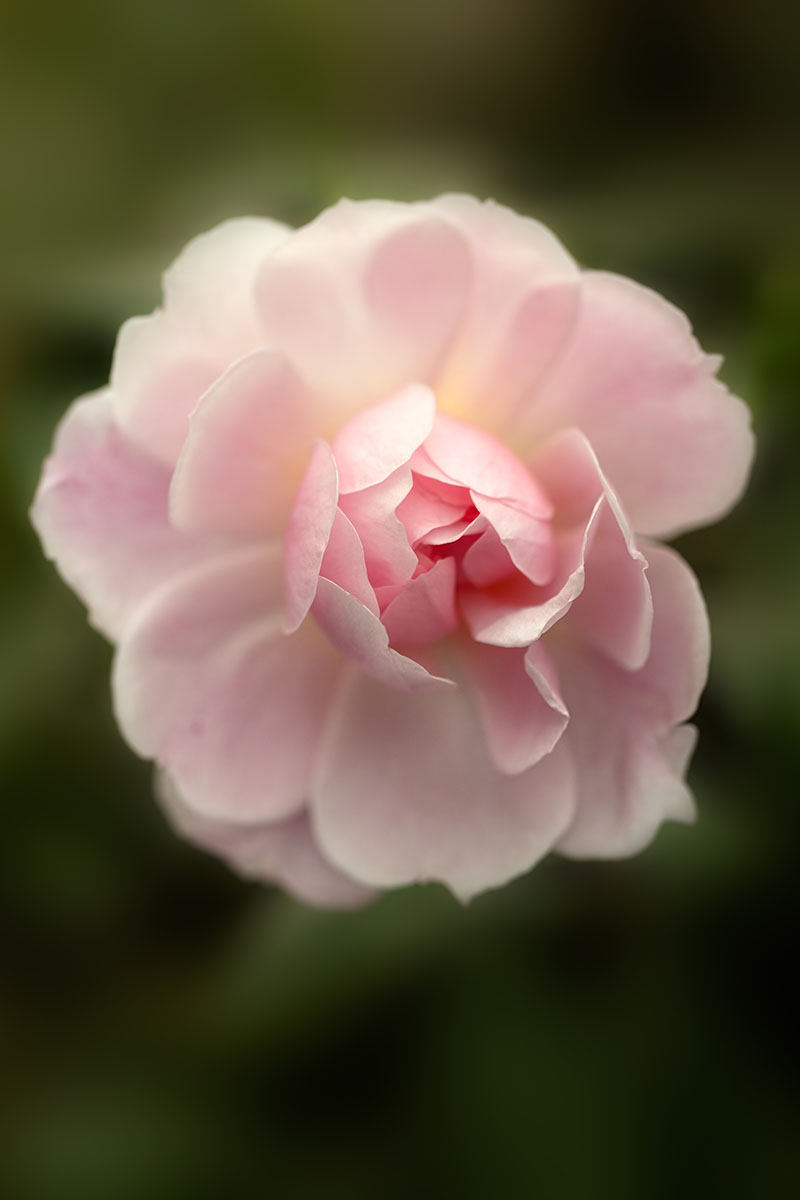

This climber is covered in sprays of true pink, double blossoms all summer long in Zones 4 to 11. When you walk past the shrub you’ll be greeted by an intoxicating mix of Old Rose and fruity fragrance on a plant that grows about 12 feet tall.
It’s also impressively disease resistant and tough, just like the English Bluestocking artist that the plant was named for. While the stems do have some thorns, they’re small and spaced far apart.
20. Nevada
Created by the prolific Spanish rose breeder Pedro Dot, ‘Nevada’ is widely considered to be his finest achievement among those in the Rosa world, and the reasons for that are readily obvious.
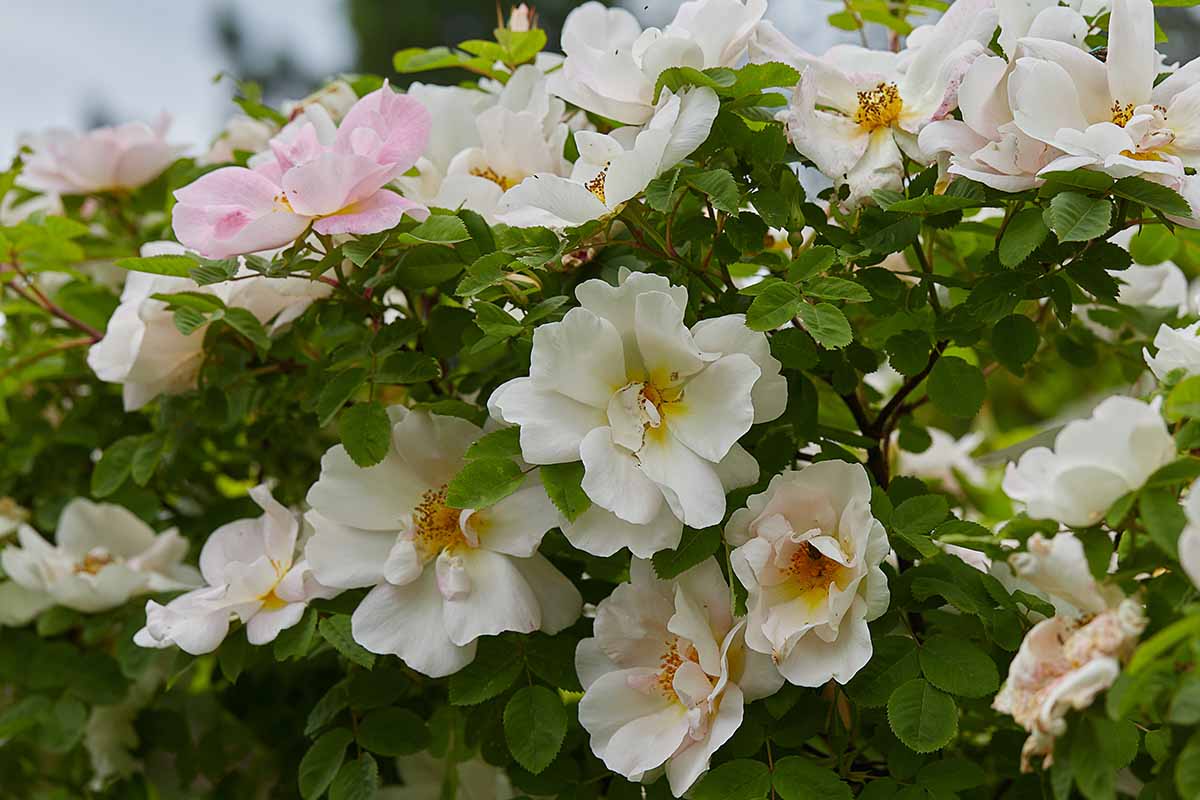

To begin with, this nearly thornless bush is practically indestructible. In arid climates, heavy rain, poor soil, partial shade, or in the face of general neglect down to Zone 3, this plant just keeps on going.
The semi-double flowers on this hybrid tea/wild rose cross are pale pink or ivory during the first flush and gradually become darker pink with later flushes. Grow it as a climber or a gracefully weeping shrub, with branches that can reach up to 13 feet long.
21. Paul Neyron
‘Paul Neyron’ is a hybrid perpetual repeat bloomer with positively massive, vivid, very double, pink blossoms.
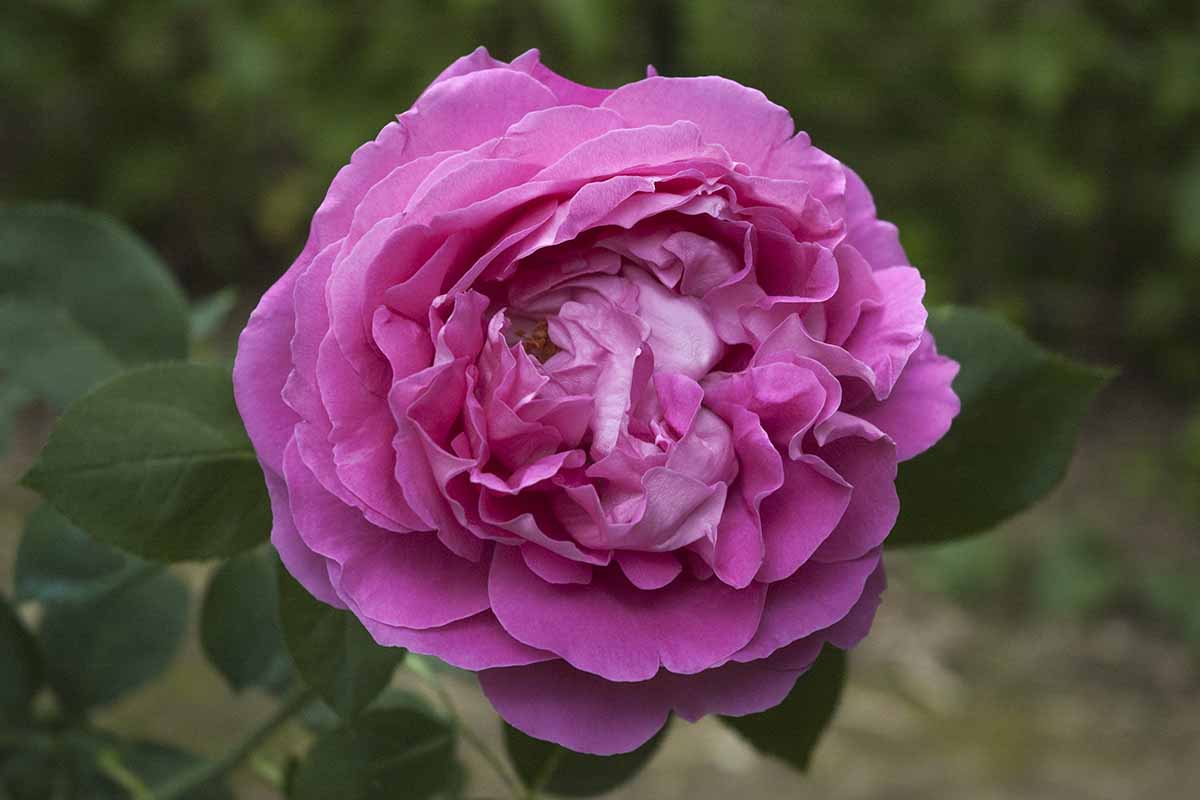

Bred in France by Antoine Levet in 1869, it grows up to six feet tall and does well in gardens down to Zone 5.
It’s an exceptional option for a cut flower garden and since it doesn’t have thorns, you won’t even have to wear gloves and long sleeves when you head out to harvest.
22. Oceana
Sweeter-looking than any creamsicle you’ll find from an ice cream truck, picture-perfect ‘Oceana’ has spirally-arranged, pointed, champagne and apricot petals on very full, extremely large blossoms that appear repeatedly throughout the summer.


Introduced in 1988 by Hans Jurgen Evers of Germany, it stays fairly petite at around three feet tall and prefers the warmer climates of Zones 6 to 9.
23. Reine des Violettes
This violet queen has reigned since 1860 when she was bred by Mille-Mallet in France from ‘Pope Pius IX.’
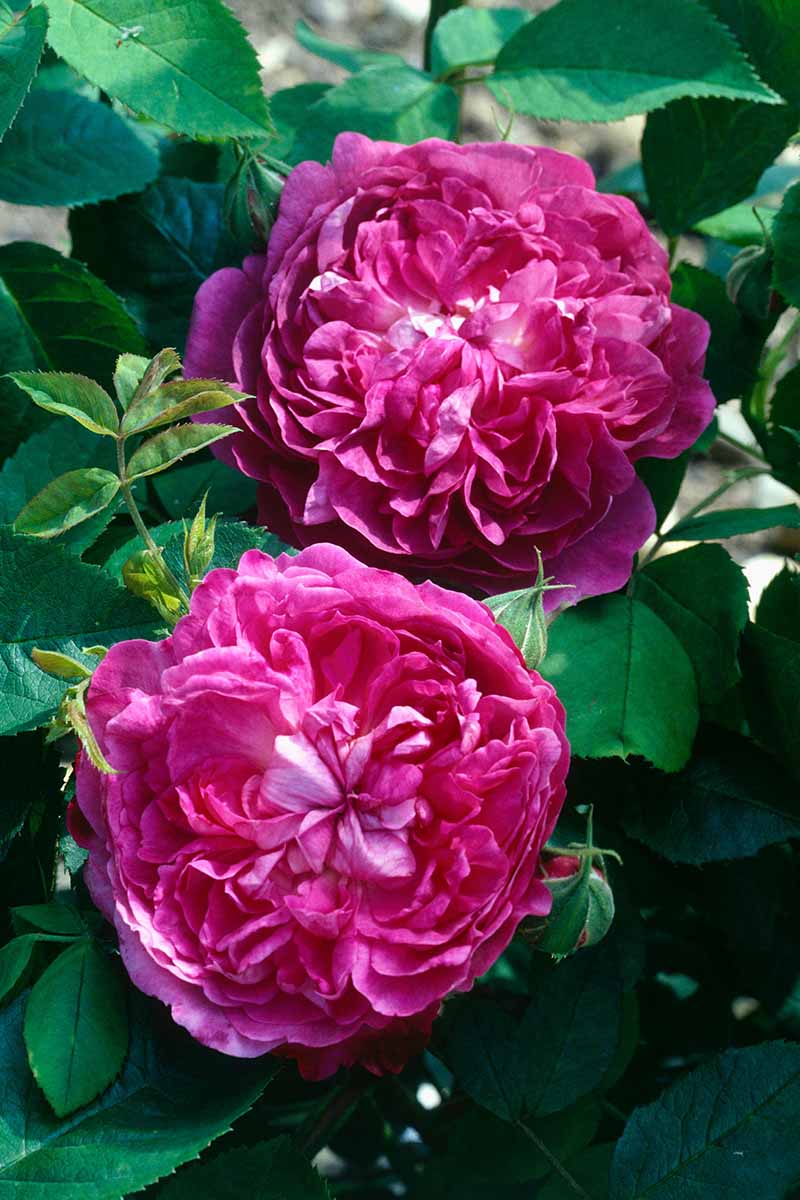

With large, magenta blossoms on four-foot canes, this cultivar is an eye-catcher wherever you plant it.
The medium-sized flowers range from lilac to deep purple, depending on the heat, sun exposure, and age of the blossom. No matter the color, each one has a heady Old Rose fragrance.
‘Reine des Violettes’ grows well down to Zone 4 and is shade tolerant.
24. The Shepherdess
With elegant apricot, very full, globular blossoms that burst forth repeatedly all summer in massive clusters, it’s all too easy to see why many have been led by this shepherdess.
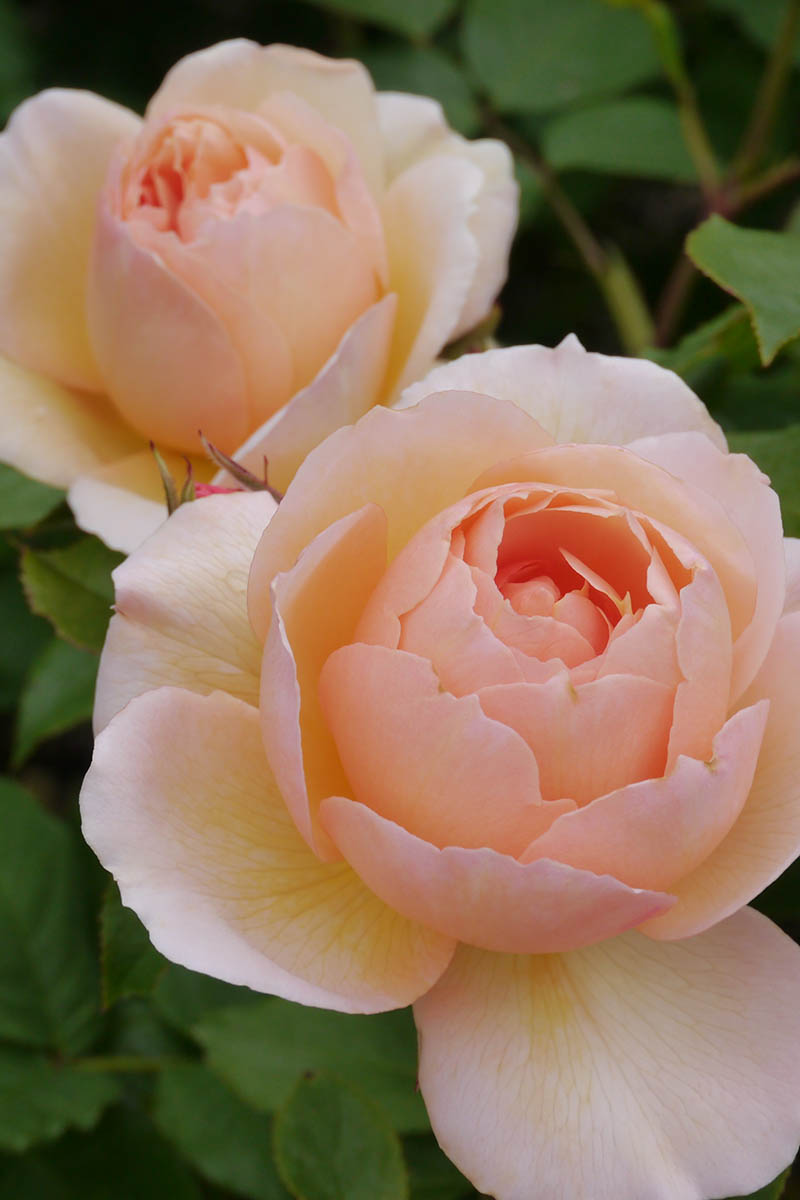

Hardy in Zones 5 to 9, this David Austin grows to about three feet tall and features a strong, fruity scent.
25. Smooth Prince
Every time I see this rose I start humming the song “Raspberry Beret.” Not just because the name practically begs you to sing your favorite Prince song, but because the shrub is covered in raspberry red double blossoms from spring until frost.
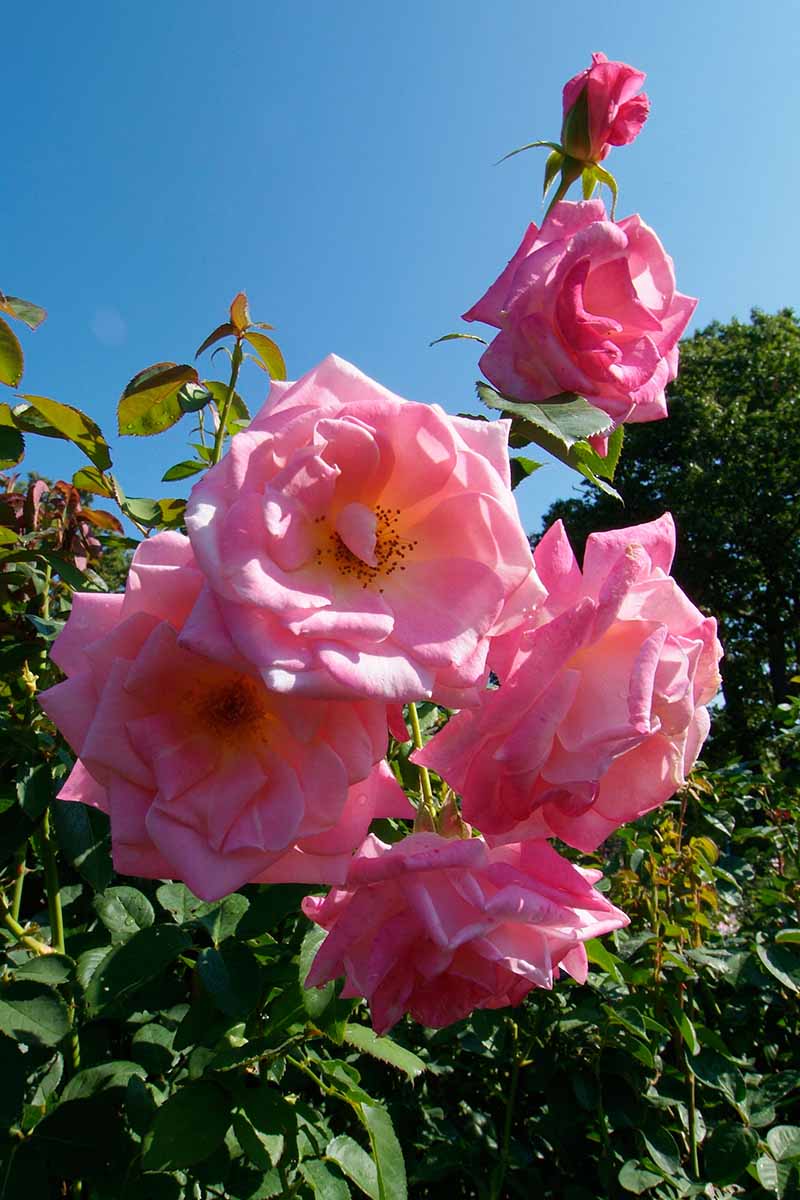

A hybrid tea, this cross of ‘Smooth Sailing’ and ‘Old Smoothie’ was introduced in 1990 and has quickly garnered a loyal audience of fans in Zones 6 to 10.
26. Tausendschon
In 1906, rose breeders Hermann Kiese and Johann Christoph Schmidt released this multiflora rose to the world and it has become a classic rambler.
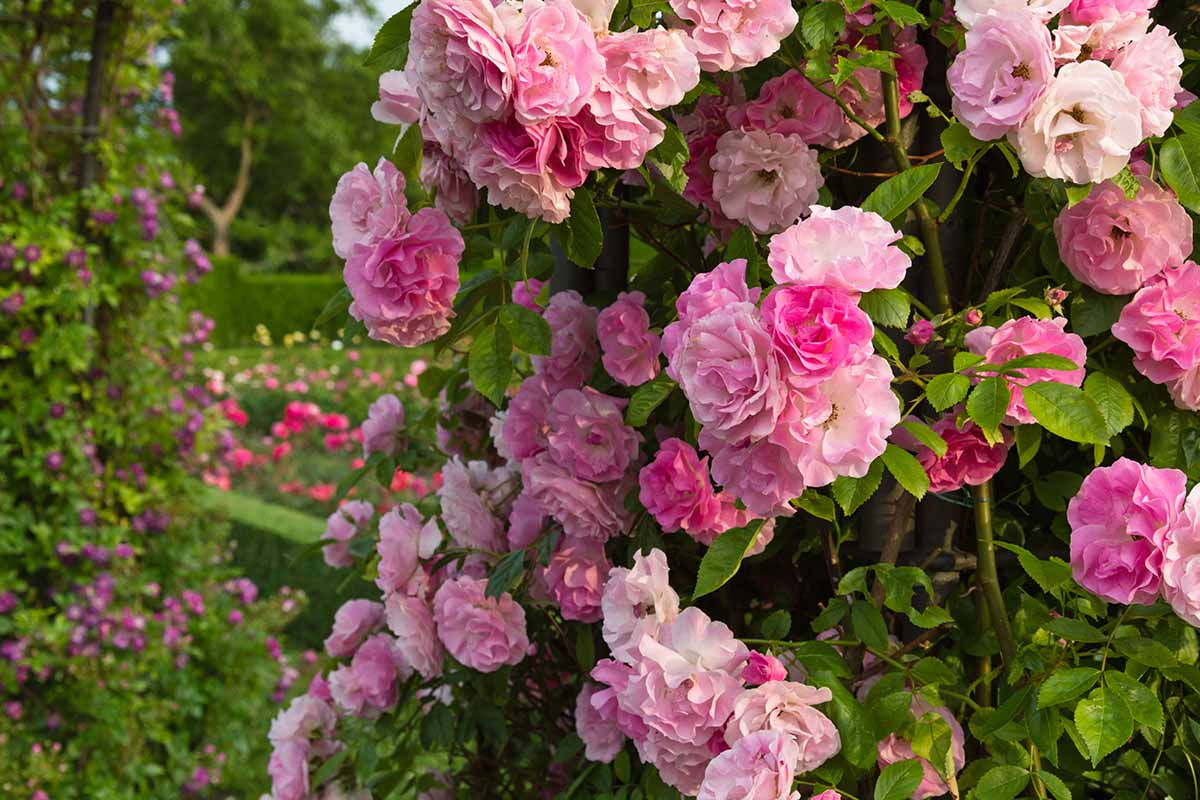

‘Tausendschön’ has fragrant, pink flowers that can vary from pale to bright. The roses are borne in large clusters on 20-foot-long canes. It reblooms repeatedly during the year and is versatile enough for Zones 5 through 10.
27. Thérèse Bugnet
This bright pink, repeat-flowering rose offers large, double blossoms on a five-foot-tall shrub. It’s marvelously adaptable and can grow in Zones 4 to 11.
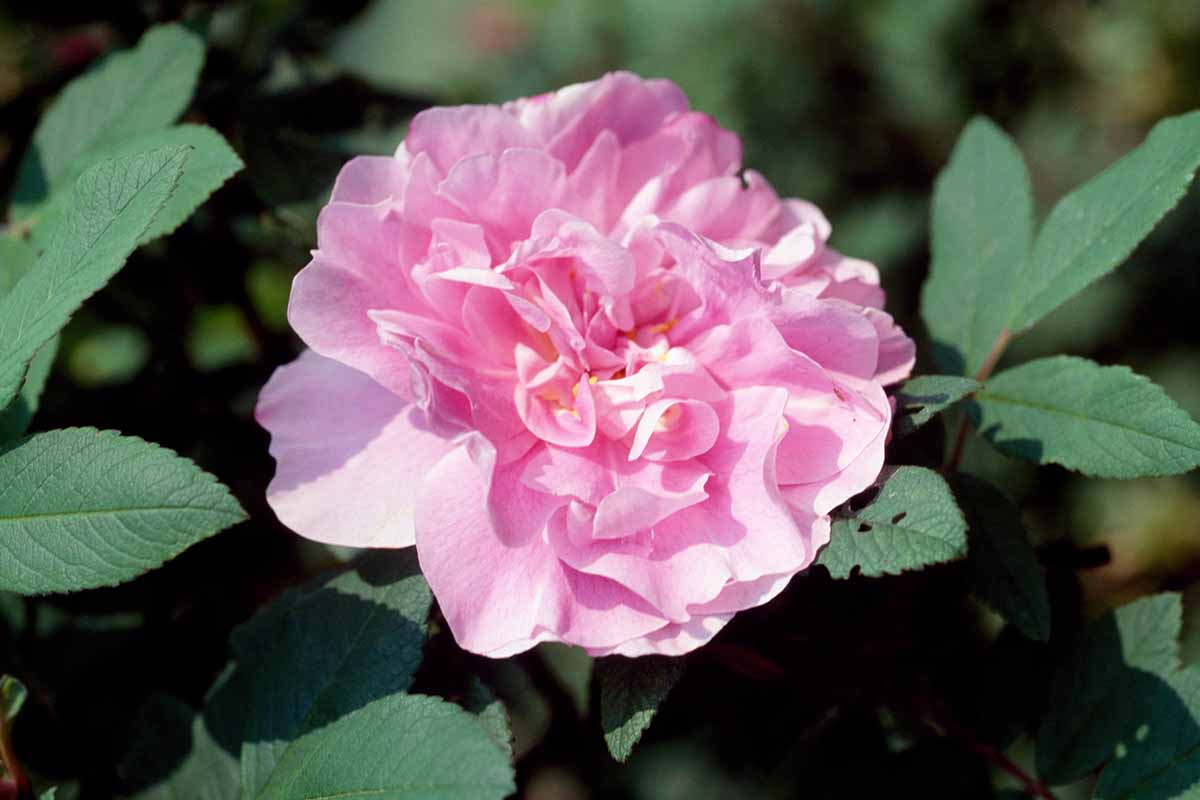

On top of that, it’s nearly immune to diseases. Seriously. If yours comes down with black spot or powdery mildew, you have some extraordinarily bad luck.
Bred by writer and hybridizer Georges Bugnet and introduced in 1941, it has since received several awards, including winner of the Classic Shrub Rose category in 2012 at the Western Reserve Rose Society Show.
28. Veilchenblau
‘Veilchenblau’ is a stunning rambler, covered in violet blossoms with white streaks and a yellow center, it has a green apple fragrance and double flowers clustered all over 20-foot, nearly thornless canes.
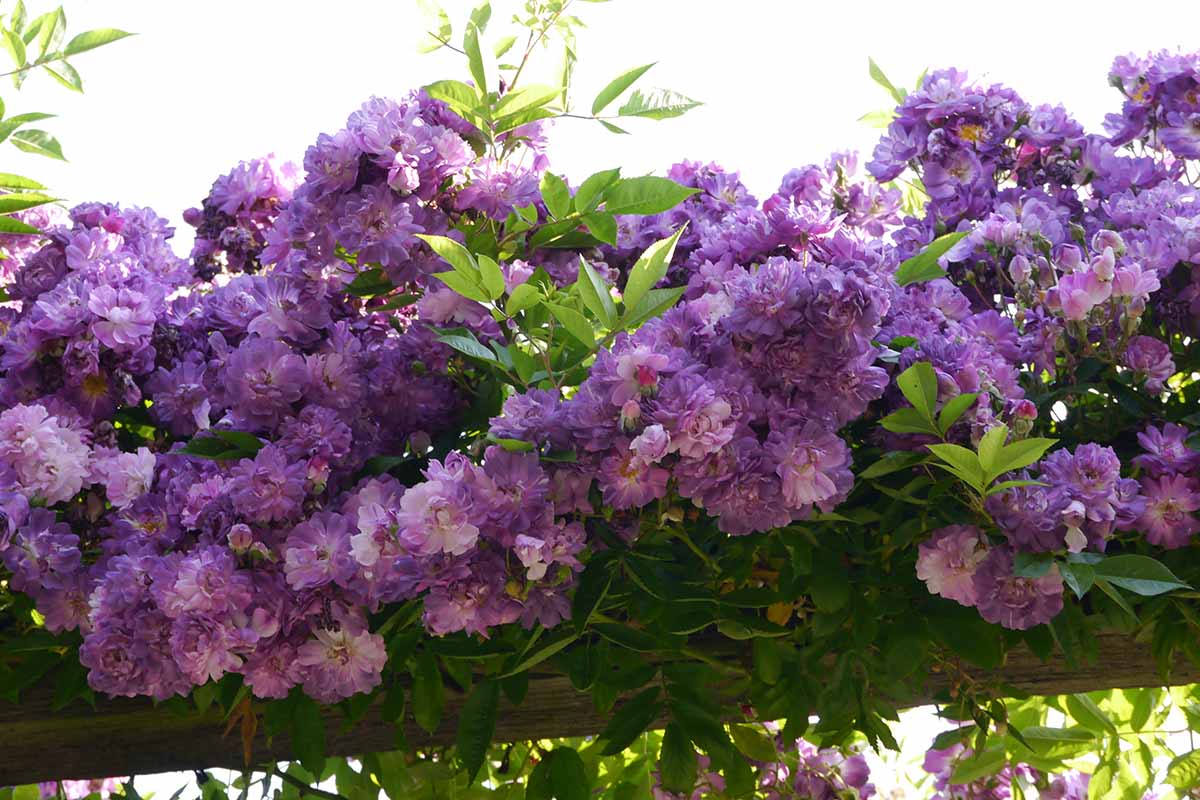

Cold tolerant down to Zone 4, this cultivar can also handle partial shade, all while growing vigorously and profusely. As the blossoms mature, they fade to a lovely lilac or nearly blue color.
A hybrid of a multiflora and a polyantha, it was bred by Johann Christoph Schmidt in 1910.
29. Zéphirine Drouhin
This Bourbon rose gets around. Bred by French rose breeder Bizot in the mid-1800s, it’s the parent of dozens of offspring, many of which carry its thornless characteristic. The semi-double, cherry-pink blossoms are heavily scented with a fruity, rose scent.
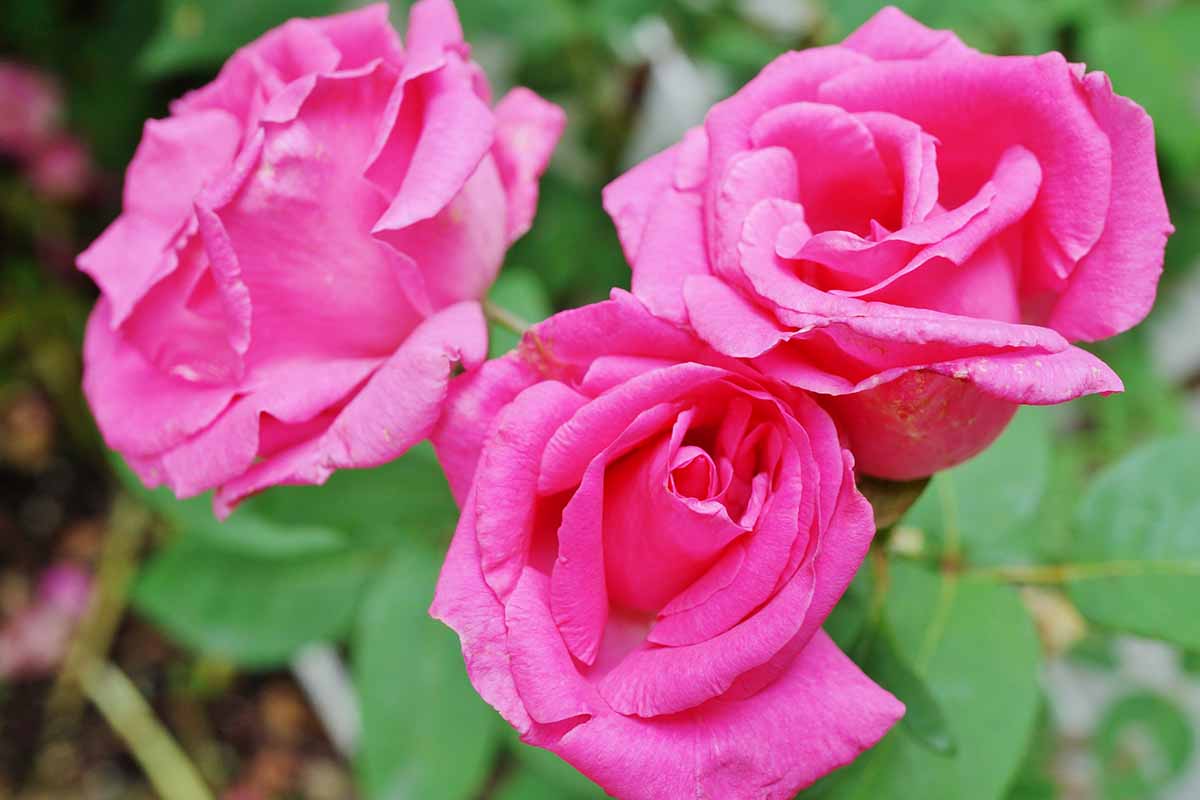

The blossoms appear in the spring and keep going through the summer, and when I tell you that there are a lot of them on each shrub, that’s not an exaggeration.
From afar, it looks like you’re seeing one mass of pink flowers. I saw one climbing an arbor and I genuinely thought it was artificial until I got up close. That’s how perfect and prolific it was.
The bad news is that it’s prone to diseases and only does well in warmer climates, in Zone 6 and up. However, if you’re willing to put in the extra effort to battle fungal problems, it’s worth keeping around.
This is a truly quintessential climber that continues to grace gardens around the world because it’s simply so stunning.
If you don’t want to deal with diseases – and I can’t blame you – look for one of its offspring, which are generally bred to be tougher.
Ready for the challenge? Fast Growing Trees carries this stunner in a two-gallon pot.
Thornless Roses Are Beauty Without the Pain
You probably don’t think much about rose prickles when you buy a plant covered in gorgeous blossoms, but you sure do once you have to reach into the shrub to pull off diseased leaves or cut a stem for a display.
When you grow one of the roses on this list, you spare yourself the blood and pain without compromising on the beauty.
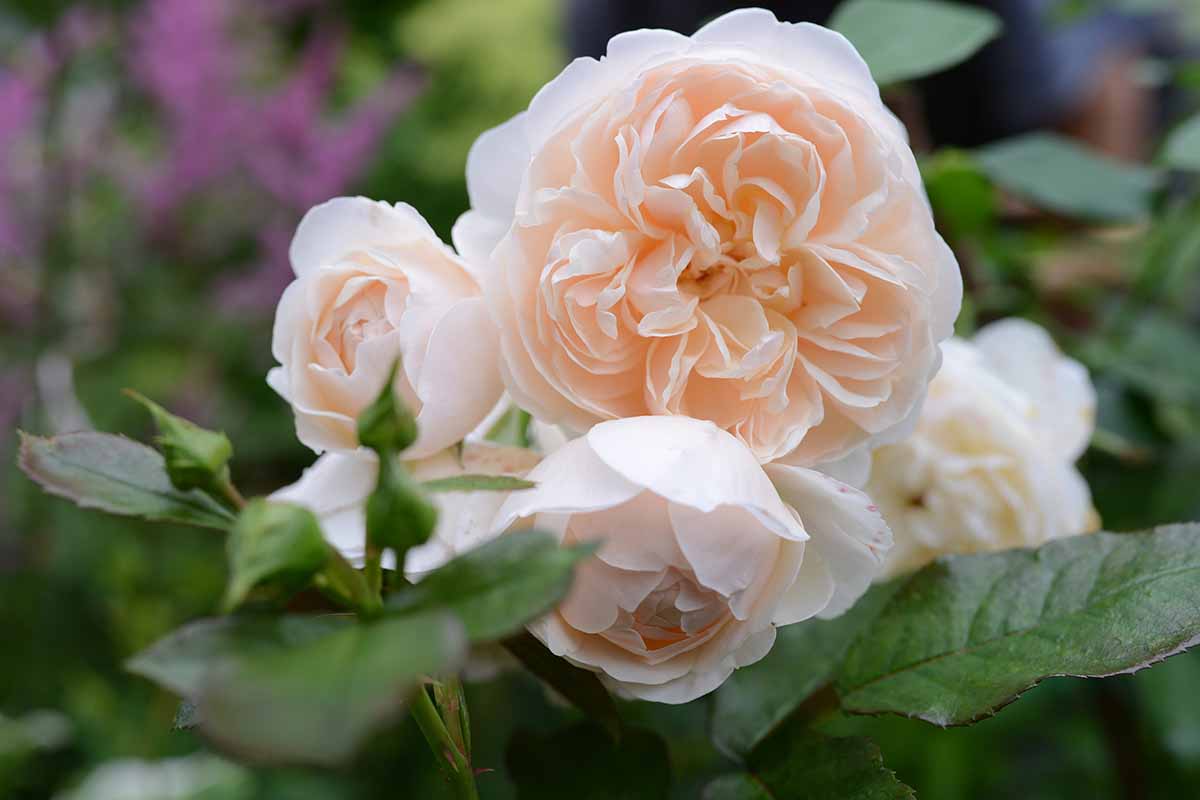

Every single one of the selections in our roundup is just as beautiful as any thorned rose – and sometimes, a ton prettier! Which one is calling your name? Let us know in the comments section below.
Now that you’ve found your new crowning glory, you might be interested in learning how to care for it. If so, we have the following Rosa guides to help you on your journey:

